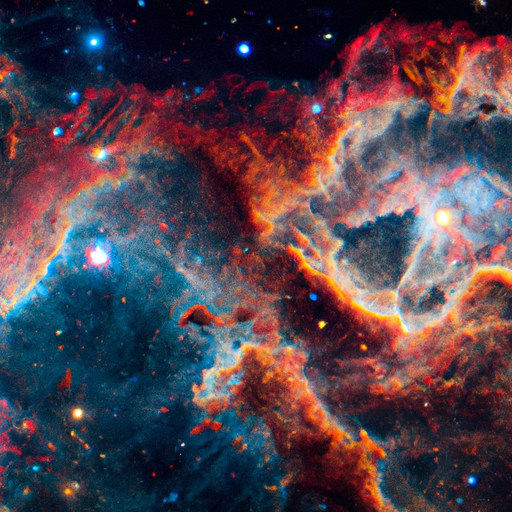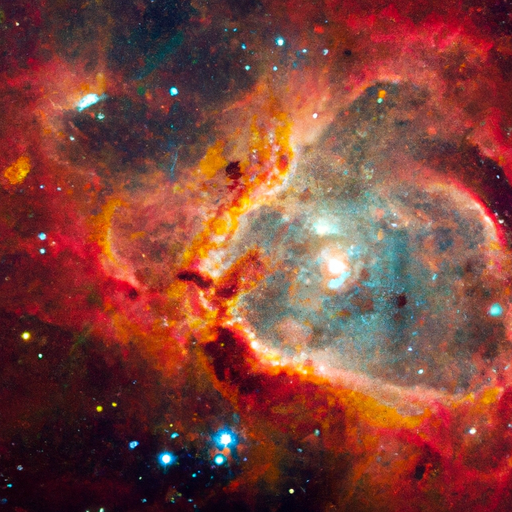Take a journey through the vast reaches of space and time as we explore the incredible phenomenon known as cosmic inflation. In this article, you will gain a deeper understanding of the rapid expansion that occurred in the early universe, and how it has shaped the cosmos as we know it today. From mind-boggling theories to groundbreaking discoveries, prepare to be amazed by the mysteries that lie beyond our world. So grab your celestial map and get ready to embark on an awe-inspiring adventure into the wonders of cosmic inflation.
What is Cosmic Inflation?
Definition
Cosmic inflation refers to a theoretical concept in cosmology that suggests the early universe underwent a rapid and exponential expansion during the first fraction of a second after the Big Bang. This expansion is believed to have occurred faster than the speed of light and is considered responsible for the uniformity and structure observed in the universe today.
Historical Background
The idea of inflation was first proposed by physicist Alan Guth in 1980 as a means to solve some of the mysteries and inconsistencies of the standard Big Bang model. Guth’s hypothesis aimed to explain the horizon problem, flatness problem, and the absence of magnetic monopoles in the universe. Since then, numerous theories and models have been developed to further refine the concept of cosmic inflation.
Theories and Models of Inflation
Inflationary Big Bang Theory
The inflationary Big Bang theory suggests that the current observable universe expanded from an unimaginably small region during the inflationary period. This rapid expansion, driven by a hypothetical scalar field called the inflaton, resulted in the universe’s large-scale homogeneity and flatness.
Inflationary Models
Several different inflationary models have been proposed, each describing different mechanisms and scenarios for the inflationary phase. These models often involve the dynamics of the inflaton field, its potential energy, and its interactions with other fundamental forces.
Guth’s Inflationary Model
Alan Guth’s original inflationary model, known as the “old inflation,” proposed that the universe underwent a phase transition, similar to the way a liquid turns into a solid during a freezing process. However, this model suffered from several critical issues, leading to the development of new inflationary models.
Chaotic Inflation
Chaotic inflation, proposed by Andrei Linde, suggests that the inflaton field is initially displaced from its equilibrium position randomly. It results in multiple pockets of inflated regions within the universe, leading to a multiverse structure.
Eternal Inflation
Eternal inflation, proposed by Andrei Linde, Alan Guth, and others, is a model that suggests inflation is not only a one-time event but an ongoing process. It theorizes that the universe contains an infinite number of pocket universes, each undergoing its inflationary phase.

Evidence for Cosmic Inflation
Cosmic Microwave Background Radiation
One of the strongest pieces of evidence for cosmic inflation is the detection of cosmic microwave background (CMB) radiation. The CMB is a faint glow of radiation that permeates the entire universe, leftover from the hot, dense state of the early universe. The uniformity and tiny fluctuations observed in the CMB align closely with the predictions made by inflationary models.
Baryon Acoustic Oscillations
Baryon acoustic oscillations (BAOs) are regular patterns observed in the large-scale distribution of galaxies. These patterns are believed to originate from sound waves traveling through the early universe during the inflationary epoch. The existence of these acoustic oscillations provides further support for the inflationary paradigm.
Large-Scale Structure of the Universe
The large-scale structure of the universe, such as galaxy clusters and cosmic web, can be explained by the gravitational collapse of tiny quantum fluctuations amplified during inflation. The precise distribution and clustering of these structures agree with theoretical predictions based on inflationary models.
Gravitational Waves
Inflation predicts the presence of primordial gravitational waves, which are ripples in the fabric of spacetime. The detection of these gravitational waves would provide strong evidence for the inflationary epoch. While gravitational waves from inflation have not yet been directly observed, their detection by experiments like BICEP2 and future missions like the European Space Agency’s LISA could confirm the inflationary paradigm.
The Inflationary Epoch
Duration and Expansion Rate
The inflationary epoch is believed to have lasted for a tiny fraction of a second, referred to as the “inflationary period.” During this time, the universe is thought to have expanded exponentially, increasing its size by a factor of at least 10^26.
Inflationary Field and Potential
The inflationary expansion is driven by a hypothetical scalar field called the “inflaton.” The behavior of this field is determined by its potential energy, which describes how the inflaton interacts with other forces in the universe. The shape of the potential energy curve plays a crucial role in determining the dynamics of inflation.
Exit from Inflation
Inflation eventually comes to an end, allowing the universe to transition into a different phase. The exact mechanism that triggers the exit from inflation is still a subject of investigation, and different models propose various scenarios. Some models suggest a sudden decay of the inflaton field, while others propose a gradual decrease in the inflaton’s potential energy.

Challenges and Criticisms
The Horizon Problem
The horizon problem refers to the observed uniformity of the universe on large scales. According to the standard Big Bang model, regions of space that are currently separated by vast distances were never in causal contact to exchange information. Inflation provides a potential explanation for this uniformity by suggesting that these regions were once close enough for information exchange during the inflationary period.
The Flatness Problem
The flatness problem relates to the observed flatness of the universe’s geometry. In the absence of inflation, the universe’s expansion should cause it to deviate from a flat geometry over time. However, observations indicate that the universe is extremely close to being spatially flat. Inflation can account for this near-flatness by stretching space exponentially during the inflationary epoch.
The Monopole Problem
The monopole problem arises from the absence of magnetic monopoles in the universe. Magnetic monopoles are predicted by certain grand unified theories, but their observation is incredibly rare. Inflation addresses this problem by suggesting that monopoles were diluted to such an extent during the exponential expansion that they become practically undetectable.
Alternatives to Inflation
While inflation has gained significant support over the years, it is not without its critics. Some alternative theories and models, such as the ekpyrotic and cyclic cosmologies, propose different mechanisms to solve the problems that inflation seeks to address. These alternatives often involve ideas from string theory and brane cosmology.
Implications of Cosmic Inflation
Formation of Cosmic Structures
The rapid expansion of cosmic inflation provides an explanation for how large-scale structures, such as galaxies and galaxy clusters, formed in the universe. Tiny quantum fluctuations during inflation serve as seeds for the gravitational collapse that eventually leads to the formation of these structures.
Origin of Matter and Dark Matter
Inflationary models also offer insights into the origin of matter and dark matter in the universe. Quantum fluctuations during inflation can generate the asymmetry between matter and antimatter and contribute to the production of particles that could make up dark matter.
Multiverse Theories
The concept of cosmic inflation has profound implications for the existence of a multiverse. Inflation suggests that our universe is just one among many bubble universes, each with its unique properties and physical laws. This idea stems from the eternal inflation model, which allows for the continuous creation of new universes.
Cosmological Observations and Experiments
Planck Satellite Mission
The Planck satellite mission, launched by the European Space Agency (ESA), has provided precise measurements of the cosmic microwave background radiation. Its observations have greatly refined our understanding of inflation and its impact on the early universe.
BICEP and BICEP2 Experiments
The BICEP and BICEP2 experiments aimed to detect signs of primordial gravitational waves from inflation in the polarization of the CMB. While initial claims of a detection were later retracted, these experiments have set the stage for future missions to explore this crucial aspect of inflation.
Upcoming Missions and Observatories
Several upcoming missions and observatories, such as the Simons Observatory, LiteBIRD, and the Cosmic Microwave Background Stage 4 experiment, are specifically designed to probe the inflationary epoch and search for evidence of primordial gravitational waves. These future endeavors hold great promise in further advancing our understanding of inflation.
Future Directions in Inflationary Cosmology
Testing the Inflationary Paradigm
Ongoing and upcoming experiments will continue to test the predictions of inflationary models, particularly in detecting primordial gravitational waves. The detection of these waves would provide direct confirmation of inflation and help determine the specific inflationary model at work.
Improving Precision of Cosmological Measurements
Advancements in technology and observational techniques will allow for more accurate measurements of cosmological parameters and phenomena. Higher precision data will help constrain inflationary models and potentially shed light on new aspects of the early universe.
Inflation in String Theory
The study of inflation in the context of string theory is another promising avenue for future research. String theory, which aims to unify all fundamental forces and particles, offers new perspectives on the dynamics of inflation and its connection to particle physics.
The Role of Inflation in Modern Cosmology
Link to Standard Model of Particle Physics
Inflation provides a link between the early universe and the standard model of particle physics. The dynamics and properties of the inflaton field can be explored within the framework of quantum field theory, contributing to our understanding of the fundamental forces and particles that govern the cosmos.
Connection with Quantum Field Theory
The study of inflation involves concepts from quantum field theory, such as the behavior of scalar fields in a quantum framework. Understanding the quantum nature of inflationary processes is crucial in unraveling the mysteries of the early universe.
Unresolved Questions
While inflation has provided compelling explanations for various cosmological phenomena, many questions remain unanswered. The nature of the inflaton field, the exact mechanism that triggers inflation, and the ultimate cause of the inflationary epoch are still subjects of ongoing research and debate.
Conclusion
Cosmic inflation represents a significant advancement in our understanding of the early universe. It provides an elegant solution to several long-standing problems in cosmology, such as the horizon problem and the flatness problem. With mounting evidence from cosmic microwave background radiation, large-scale structure observations, and the search for primordial gravitational waves, inflation has become an essential component of modern cosmological theories. While there are challenges and alternative proposals, ongoing research and future missions hold great promise in further unraveling the mysteries of inflation and its role in shaping our universe.